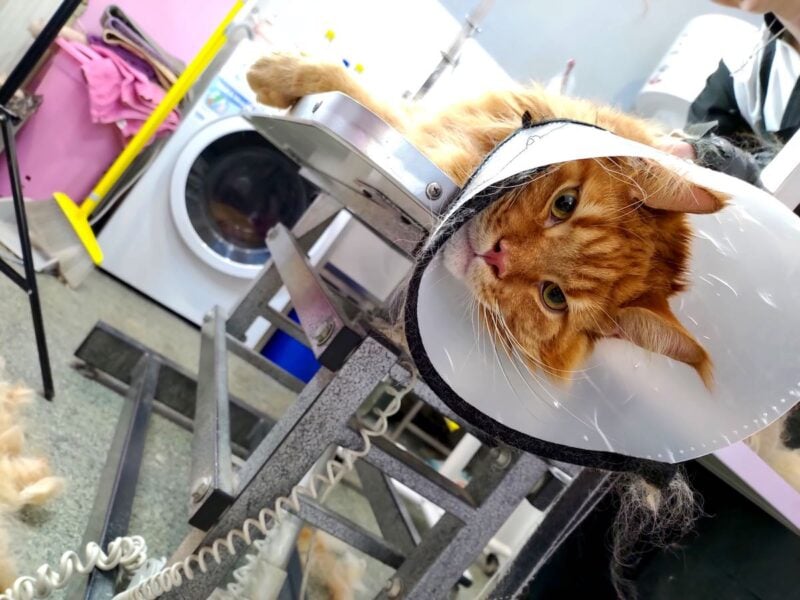Trimming Maine Coon Paw Tufts

If you are preparing to trim your Maine Coons paws and claws for the first time, or perhaps you are a seasoned cat owner who wants to double-check their method, you’ve arrived at the right place!
Trimming Maine Coon paw tufts is not an overly difficult task. But, it requires the right methodology and attention to detail.
Maine Coon Paw Tufts
Maine Coon fur on and around the paws can grow quite long. This fur can become easily knotted and this can be uncomfortable for your Maine Coon cat. Owners should ensure their Maine Coons paw is properly groomed and any long tufts are carefully trimmed with sharp, clean, scissors.
To survive the harsh climate of Maine, US before becoming domesticated felines, these large cats developed thick, warm, coats and tufted paws to keep them warm.
These cats have large paws with furry tufts around their “ankles” and between their toes. This helped to protect their feet from rocks, stones, ice, and snow.
Trimming Cats Paws Tufts
Whether you should trim your Maine Coon toe tufts, or not, is a frequently debated topic! Some owners argue the cat needs tufty toes, whereas others say they don’t since these former wild cats no longer live in the wild!
Their tufts are perfectly fine growing long and wild. The only issues arise if the cat toe tufts are particularly thick and suffer from matting and trapped debris.
You should only trim a cat’s toe tufts if they become an issue (source 1).
When To Trim Hair On Cat’s Paws:
- If the fur on your cat’s paws is bothering him/her and causing them to lick repetitively and chew their feet.
- When the fur is beginning to matte and turn into a knotty mess.
- If your vet recommends that you trim them.
- If they are inadvertently carrying litter from their litter box around with them.
When NOT To Trim Hair On Cat’s Paws:
- Because you are bored!
- Because you want to style your cat to look “better”.
- If your Maine Coon spends a lot of time outside in the cold they will appreciate their long-toe tufts.
How To Trim Your Cat’s Paw Tufts
Here are some cat grooming tips that will guide you when trimming your Maine Coon cat’s paw tufts (source 1):
1. Making Them Comfortable
The first step is to create a comfortable setting to trim your Maine Coon cat’s paw tufts.
2. Touching Their Paws
Get your Maine Coon used to you touching their feet so they are less likely to kick and squirm when you try to trim their toe tufts.
3. Scissors
Look for the obvious stray paw hairs that you can quickly trim.
Carefully cut this fur as close to their paw as possible, without actually touching their paw.
4. Paw Fur Trimmers
Always use a reliable cat paw hair trimmer, like this one sold on Amazon. This is one of the best cat paw hair trimmers’ I have ever used.
When it comes to how to trim cat paw fur, the trimmer simply follows the outlines of the cat’s paws and trims away wayward hairs.
The trimmer, while safe to the touch, should come into little to no contact with the skin of your cat.
A paw trimmer can fit neatly between the pads of your Maine Coons paws.
Cat Breeds With Tufts Of Fur Between Toes
Here are some other cat breeds that are known for having tufts of fur between their toes:
- Persian
- Norwegian Forest Cat
- Himalayan
- Angora
- Ragdoll
- Siberian
Should You Trim Maine Coon Ear Tufts?
Not all Maine Coons grow fantastical ear tufts, or even noticeable ones, though they all tend to have some ear fur. This is common in cat breeds that have had to adapt to living in very cold environments.
Maine Coon ear tufts start to grow during adolescence and continue to grow well into old age. Lengthy tufts can be a sign of old age!
Here is a quick breakdown of what purpose Maine Coon ear tufts serve and whether you should trim your cat’s ear tufts (source 1):
- Warmth: Their tufts keep their heads and ears warm. Their ears are thin and exposed to the elements. Body warmth can escape through their ears quite quickly in cats and people alike so you should never trim a Maine Coon cat’s ear tufts.
- Protection From Snow: Ear tufts will keep snow and ice from getting inside your cat’s ears and damaging their sensitive eardrums.
- Protection From Mites: Ear hairs also serve to protect your cat’s ears from mites, however, they can also become infected during the process at which point they will need to be trimmed and cleaned thoroughly.
- Self-Cleaning Ears: Cat’s ears are self-cleaning, just like ours. Unfortunately, sometimes ear tufts can prevent the cleaning process, and the ears just become blocked with wax and hair. This is a good indication that their ears could use a clean and trim.






